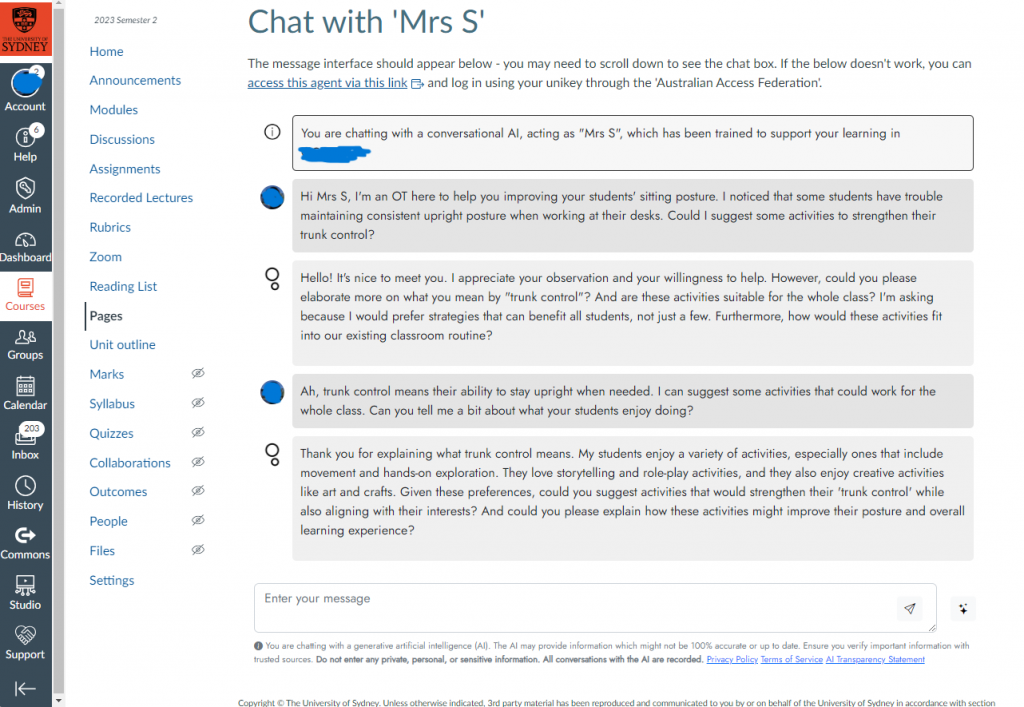Working in collaboration with Educational Innovation, Joanne Hinitt from the Faculty of Medicine and Health recently designed and ran a workshop with interactive chatbots to provide students with a safe and authentic learning experience, supported by generative AI. Her workshop activities had students developing intervention plans for an authentic client and then interacting with the client’s classroom teacher to discuss the plan.
This provided all of Joanne’s students with immediate feedback, an opportunity to adapt their plans and their communication skills in real time.
I thought it was really cool that the AI could process our responses and ask helpful questions to progress our thinking.
Building confidence and disciplinary expertise
Second-year undergraduate occupational therapy students are relatively new to the field and have not yet experienced long placement blocks, which usually occur in their third year. Due to the COVID-19 pandemic, students have faced challenges in engaging with active learning and building connections with each other. They also expressed feeling overwhelmed by the amount of assumed knowledge in previous learning activities.
The objective of the workshop activities was to equip students with the ability to develop occupational therapy plans and strategies to support children experiencing handwriting difficulties at school. They also needed to provide clinical reasoning to explain and justify these plans and present them to a classroom teacher in a collaborative and inclusive manner.
Additionally, the students were to explore using generative AI tools in occupational therapy practice in a responsible way, identifying advantages and challenges in the process. Joanne was conscious that she could no longer assume that students are unaware of the potential of AI and that she has a responsibility to shape the professional and ethical use of AI in clinical practice.
Overcoming barriers to student learning
One of the main obstacles for learning at this stage in the program is students’ lack of real-world occupational therapy experience and professional knowledge. Because of this, they have historically found it challenging to design intervention plans based on theory, evidence, and creativity.
Another significant consideration in the development of this activity was the desire to encourage more active learning and student-student collaborative behaviours in the classroom which Joanne perceived to have diminished due to remote learning during the COVID-19 pandemic.
Interacting with generative AI safely and meaningfully
Joanne converted existing learning content into an active workshop, designing some pre-work and then dividing the session into three parts.
Her students participated in an asynchronous preparation activity to examine ethical and professional considerations of AI use. Students watched a 15-minute mini-lecture that included some interactive polls asking them to consider if and how AI might support occupational therapy practice and what some of the ethical considerations of its use might be.
The three-hour workshop was structured into three parts. In each part of the workshop, Joanne provided scaffolding and context to support her students’ thinking and reasoning process.
- Background information: Lecture style teaching on occupational therapy intervention plans and strategies to support handwriting development.
- Introduction of the client example: Students were introduced to a client named Jake. Jake is a 5 year-old kindergarten student in a class of 25 – 30 students taught by ‘Mrs S’. Working in groups of four, students were given time to discuss possible strategies and supports for Jake, and their rationales. They were then provided with access to a University-provisioned GPT-3.5 service to assist them with generating strategies and support for Jake.
- Presenting plans and ideas to the classroom teacher: This involved role-playing with ‘Mrs S’, a generative AI tool that had been specifically instructed to act as Jake’s classroom teacher. This encouraged students to think about their suggestions and how to communicate and collaborate with a teacher. Students received immediate responses from Mrs S., providing them with opportunities to refine both their strategies and their communication.
The generative AI tools were specifically customised for this activity, using a new tool being developed and piloted at the University of Sydney called Cogniti. First, students were introduced to a Cogniti chatbot that gave them access to generic GPT-3.5 to help generate ideas and develop a plan based on their understanding of the appropriate strategies and intervention plan requirements covered in the initial lecture.
Then, students were introduced to a second Cogniti chatbot acting as Mrs S. This chatbot was informed by a range of relevant background information including an outline of the NSW Early Stage 1 Teaching Curriculum, Disability and Inclusion policy and common teacher responses to occupational therapy mistakes students and novice occupational therapists may make when presenting and discussing occupational therapy plans and strategies with them. Mrs S was prompted to respond like a time-poor classroom teacher, wanting the best for all her students. After some testing and tweaking, Mrs S was able to engage in a meaningful interaction with students in real time. Mrs S was able to ask for more or less detail as needed, seek clarification of clinical aspects of the plan, and ask pertinent questions about how plans would impact other students in her class or make Jake feel if he was doing different activities to his peers.
While her students were chatting with the Mrs S AI, Joanne was able to immerse herself in the class and talk to groups to support them when Mrs S was asking challenging questions. This allowed Joanne to turn an otherwise passive learning experience into an interactive and collaborative one.
We’ve outlined the process to make these chatbots elsewhere. Cogniti allowed us to easily tweak the instructions that the generic GPT-3.5 chatbot, and the Mrs S chatbot, were given, to ensure that they were useful. Cogniti allowed Joanne to provide equitable, safe, and private access to generative AI for her whole class. It also allowed her to ensure the AI was responding to students as intended. Students accessed the Cogniti chatbots seamlessly through Canvas, so they didn’t need a separate login.
I’m actually very surprised in how well the AI Mrs S can respond to my ideas and come up with clarifying questions. This allows me to review my suggestions in different perspectives, making my intervention plans more comprehensive and detailed.
Reflections and future improvements
Generally, Joanne found the use of AI tools beneficial. In part 2, where students used a generic GPT-3.5 chatbot, she noticed that students interacted with the AI more like a search engine than a collaborative tool. More explicit instruction on interacting with AI could be beneficial here. That said, students identified that AI might be a useful tool to use (to come up with support plans) but to use it with caution and thought and with professionalism – such as not give it confidential and personal information.
Role-playing with the AI teacher in part 3 was a valuable learning experience. It allowed students to practice presenting their plans in a simulated yet realistic scenario, although some needed guidance to maintain professionalism and speak in full sentences during the role play. Joanne reflected that the AI provided her students with a deeper learning experience because it allowed them to explain their recommendations in teacher-friendly terms, think about what they were asking Mrs S to do, ensure that the interventions were realistic and suitable, and explain their recommendations. This would not have been possible if they had just conducted a role play with each other, as they do not yet have the level of experience and knowledge.
I thought the AI was very good, there was a balance between challenging our suggestions that encourages us to think and back up our ideas, and affirming our suggestions with add-ons that improve the strategy delivery.
In future iterations, Joanne plans to shorten the preparation video and post it earlier to give students more time to reflect. She also plans to implement professional language guidelines for interacting with the AI teacher, Mrs S.
Despite the newness, the use of generative AI in teaching occupational therapy was seen by both Joanne and her students to be a valuable tool to practice their skills in a safe and controlled environment. Another student commented:
This is such an awesome way to practice talking with clients/teachers/parents/etc in an appropriate way.
This positive feedback reaffirms the potential benefits of using AI tools in teaching and learning activities.






